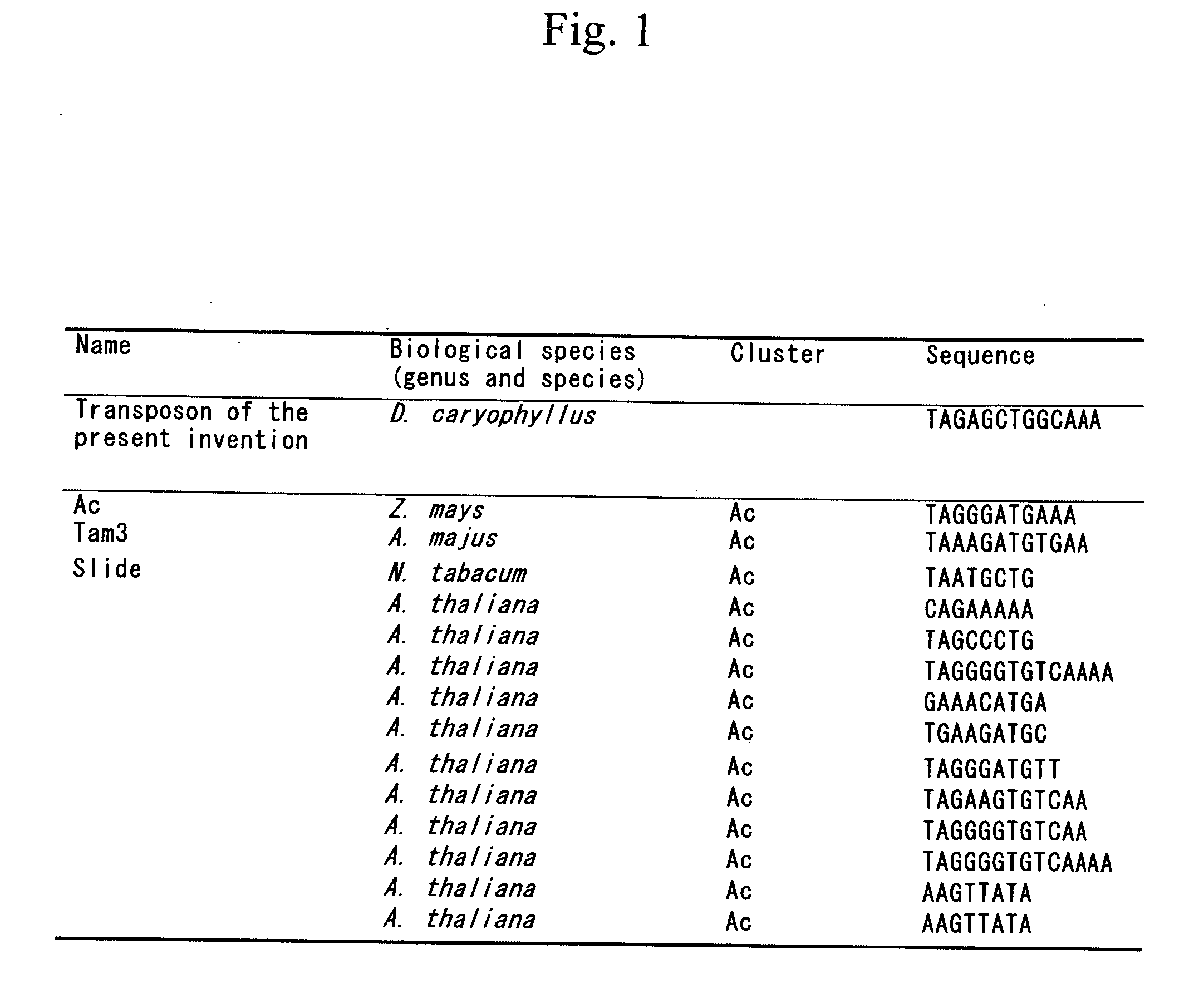Method for detecting mutation and method of inducing the same
a mutation and mutation technology, applied in the field of mutation detection, can solve the problems of high labor intensity, no analogous properties observed concerning an internal nucleotide sequence of approximately 4 kb, and the inability to specify a mutated gene in mutants obtained by such conventional methods, and achieve the effect of facilitating the induction of bud mutation, detecting bud mutants, and facilitating the isolation of causative genes
- Summary
- Abstract
- Description
- Claims
- Application Information
AI Technical Summary
Benefits of technology
Problems solved by technology
Method used
Image
Examples
example 1
Analysis of Carnation Petal Pigments
[0128] Carnation petal pigments were analyzed according to the method of Masaatsu Yamaguchi (MINAMI KYUSHU UNIVERSITY Bulletin of the Faculty of Horticulture (1988), Vol. 19, pp. 1-78: Basic Studies on the flower color breeding of Carnations (Dianthus caryophyllus L.)). Petals from carnation clones 95SP and 97SPi were each subjected to extraction with 5% acetic acid and 50% ethanol, followed by development with TLC (acetic acid:hydrochloric acid:water=15:3:82). These development images were compared with an image of an extract from carnation petals (variety: Barbara (Hilverda Plant Technology)) having a known pelargonidin 3 glucoside 5 glucoside (Pg3G5G) pigment and compared with an image of an extract from carnation petals (variety: Lilac (SIRI BROTHERS NURSERY, INC.)) having a cyanidin 3 glucoside 5 glucoside(Cy3G5G) pigment. Thus, it could be inferred that 95SP mainly contained a pigment having the cyanidin backbone and 97SPi contained a pigm...
example 2
Preparation of Carnation Genomic DNA
[0129] The DNAs of carnation clones 95SP, 97SPi, 97SE, 99SP5, and 99SP4 were prepared using in vitro leaf sections as materials by Nucleon PhytoPure (Amersham) according to attached protocols.
[0130] In addition, 99SP5 and 99SP4 were obtained by the following techniques and then used as materials. 1000 in vitro plants with a height of approximately 5 cm were subjected to X-ray irradiation with a dose of 4 KR according to a standard method. The plants were acclimatized in a greenhouse. Axillary buds were collected and grown. Axillary buds were collected again from plants that had developed roots and then the buds were grown. Such steps were repeated several times. As a result, two plants (99SP5 and 99SP4) developing pink flowers (plants developing the same flower color as developed by 97SPi) were obtained.
example 3
Preparation of Carnation cDNA
[0131] Carnation clone 95SP RNA was prepared according to the method described in Cell Engineering, Separate Volume, Plant Cell Engineering Series 2, Plant PCR Experimental Protocols (1995) 42-43. Then, the cDNA was prepared using RNA isolated from petals by a cDNA synthesis kit (TAKARA BIO INC.) with a 1 8-nucleotide-long dT primer attached to the kit according to the attached protocols.
PUM
| Property | Measurement | Unit |
|---|---|---|
| Current | aaaaa | aaaaa |
| Efficiency | aaaaa | aaaaa |
| Frequency | aaaaa | aaaaa |
Abstract
Description
Claims
Application Information
 Login to View More
Login to View More - R&D
- Intellectual Property
- Life Sciences
- Materials
- Tech Scout
- Unparalleled Data Quality
- Higher Quality Content
- 60% Fewer Hallucinations
Browse by: Latest US Patents, China's latest patents, Technical Efficacy Thesaurus, Application Domain, Technology Topic, Popular Technical Reports.
© 2025 PatSnap. All rights reserved.Legal|Privacy policy|Modern Slavery Act Transparency Statement|Sitemap|About US| Contact US: help@patsnap.com



